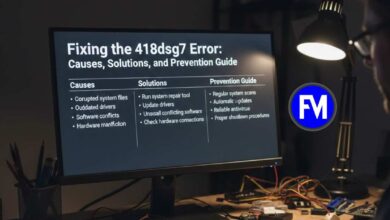Is Software Doxfore5 Dying? A Complete 2025 Guide to Legacy System Migration

In today’s fast-paced digital environment, companies are rethinking legacy software strategies to stay competitive and secure. A major topic stirring concern in IT and operations circles is the decline of Software Doxfore5—a once-popular document management solution now facing a slow but unmistakable sunset.
The question “Is Software Doxfore5 dying?” isn’t just about obsolescence—it’s about risk, cost, compliance, and missed opportunities. As signs mount and doxfore5 support ends, organizations still relying on the platform must evaluate how to transition to cloud-first document management systems that support artificial intelligence (AI), automation, and modern compliance frameworks.
This article provides a clear, actionable breakdown of the Doxfore5 software decline, the risks it presents, and how to migrate safely and smartly in 2025. Whether you’re an IT manager, CIO, or business owner, this guide will help you plan for a smooth, secure, and future-ready transition.
What Is Software Doxfore5 Dying?
Doxfore5 was originally introduced as a document management system (DMS) designed to centralize business documents, automate workflows, and enhance regulatory compliance. It helped organizations streamline contract management, invoice approvals, HR records, and more.
But by 2025, Software Doxfore5 is dying—not because it failed in its original mission, but because it didn’t evolve. In a cloud-first world where digital agility, real-time collaboration, and AI integration are baseline requirements, Doxfore5 remains rooted in an outdated software architecture that no longer meets the demands of modern business.
As organizations ask “Is Doxfore5 shutting down?” or “Can it be saved?”, the answer lies in the red flags of a legacy platform in decline.
Signs That Doxfore5 Is Dying
Every piece of software enters an end-of-life (EOL) phase eventually. In the case of Doxfore5, the signs are unmistakable and increasingly urgent:
1. Lack of Product Updates
- No major features added in recent years
- Delayed or skipped security patches
- Incompatibility with modern operating systems (Windows 11, macOS Ventura)
2. Decline in Community and Support
- Fewer developer discussions in forums
- Decreased user-generated resources
- Drop in third-party integrations and plug-ins
3. Mounting Security Risks
- Legacy code with known vulnerabilities
- No two-factor authentication (2FA) support
- Poor encryption standards
4. Vendor Silence
- Ambiguous communication on future roadmap
- No published compliance updates
- Doxfore5 support ending or drastically scaled back
LSI Keywords: end-of-life software risks, outdated document systems, legacy DMS issues, doxfore5 no longer supported
These are not isolated issues. Collectively, they signal that Doxfore5 is entering its sunset phase, and businesses must prepare accordingly.
Business Impact of Outdated Software
Legacy systems like Doxfore5 don’t just slow you down—they create material risk across your operations.
1. Operational Inefficiencies
- Manual workarounds waste time
- No AI document classification
- Limited workflow automation
2. Rising Costs
- IT labor spent on patches and maintenance
- Integration workarounds with modern CRMs and ERPs
- Downtime due to software crashes
3. Compliance and Legal Risk
- Lack of GDPR, HIPAA, or ISO 27001 support
- Poor audit trails
- No data residency controls
4. Data Vulnerability
- Easier target for ransomware and malware
- Unencrypted or poorly encrypted storage
- No support for advanced threat detection
For small and mid-size businesses, the impact of Doxfore5 on SMBs can be especially harmful—leading to client losses, lawsuits, or failed audits.
Why Old Software Dies
Understanding why old software dies can help businesses avoid repeating history.
1. Failure to Modernize
- Cloud migration is now the norm; Doxfore5 is still server-bound
- No mobile-first or browser-native experience
- Lack of machine learning and AI capabilities
2. Architecture Inflexibility
- No support for REST APIs or integration standards
- Locked-in data formats
- Inability to scale horizontally
3. Vendor Misalignment
- Companies that don’t invest in R&D
- Weak partner ecosystems
- No commitment to long-term updates
When innovation stops, product death becomes inevitable.
Doxfore5 vs Competitors
Let’s compare Doxfore5 vs its modern competitors to understand how far behind it has fallen.
| Feature | Doxfore5 | SharePoint Online | Google Workspace | M-Files |
|---|---|---|---|---|
| Cloud-native | No | Yes | Yes | Yes |
| AI-Powered Tagging | No | Yes | Yes | Yes |
| Mobile Optimization | Limited | Full Support | Full Support | Full Support |
| Compliance Automation | Weak | Strong | Strong | Moderate |
| Integration Ecosystem | Poor | Microsoft 365 | Google Apps | ERP/CRM compatible |
In virtually every category, Doxfore5 is now outdated. Competitors are offering better UX, more automation, and stronger security.
Doxfore5 Alternatives in 2025
Businesses looking to transition away from Doxfore5 have several powerful options in 2025. Here are the top Doxfore5 alternatives:
1. Microsoft SharePoint Online
- Deep integration with Microsoft 365
- Advanced document workflows and metadata
- Excellent for compliance-heavy industries
2. Google Workspace Drive
- Real-time collaboration
- Intuitive and scalable
- Easy deployment for remote and hybrid teams
3. Box for Business
- Secure cloud document storage
- Rich compliance and governance tools
- Scalable for global teams
4. M-Files
- Metadata-driven document management
- Excellent automation features
- AI-assisted classification
5. Zoho Docs / WorkDrive
- Budget-friendly for SMBs
- Good mobile and web support
- Basic automation and sharing features
6. Laserfiche, Hyland OnBase, Everteam
- AI-powered document management software
- Used in government, finance, and healthcare
- Strong compliance frameworks built-in
Crafting a Doxfore5 Migration Strategy
A successful transition from Doxfore5 requires more than just picking a new tool. You need a structured migration plan.
Step-by-Step Doxfore5 Migration Strategy
- Assessment
- Evaluate your current Doxfore5 environment
- Identify user workflows, integrations, and document volumes
- Risk Analysis
- Assess compliance and security risks in current system
- Evaluate regulatory gaps
- Solution Selection
- Choose the best Doxfore5 alternative for your business model
- Consider scalability, integrations, and pricing
- Data Cleanup and Preparation
- Eliminate redundant files
- Categorize by metadata for smooth transfer
- Migration Execution
- Use professional tools or vendors to move data securely
- Validate accuracy post-migration
- Integration
- Connect with CRM, ERP, HR systems
- Test interoperability
- Training and Change Management
- Provide user onboarding, tutorials, and admin training
- Ensure staff adopts new systems confidently
- Monitoring and Optimization
- Track usage, errors, and user feedback
- Continuously improve based on performance data
Security and Compliance Concerns
Using end-of-life document management systems like Doxfore5 can expose businesses to significant regulatory and security vulnerabilities:
Top Risks
- Unpatched vulnerabilities leave systems open to attacks
- Lack of compliance features violates GDPR, HIPAA, or SOC 2
- Weak audit trails hinder investigation after breaches
Why Migrating Improves Security
- Cloud-first platforms include automatic updates
- Built-in compliance frameworks ensure readiness for audits
- Stronger encryption and identity access management reduce risks
Lessons from Doxfore5 Failure
The decline of Doxfore5 offers clear takeaways for IT leaders and software buyers:
1. Don’t Ignore Innovation
Software must evolve with user expectations, security standards, and industry trends. Legacy systems that remain static will lose relevance—and users.
2. Evaluate Vendor Commitment
Before adopting any business-critical tool, ensure the vendor shows a roadmap, funding, and support ecosystem that align with your future needs.
3. Build a Legacy Software Exit Strategy
Organizations should periodically review and retire old software, maintaining business agility and compliance without waiting for failure.
Conclusion
So, is Software Doxfore5 dying in 2025? All evidence points to yes.
From lack of updates to rising security risks and fading support, the platform is clearly reaching the end of its life cycle. While the vendor may not have officially declared a shutdown, smart businesses aren’t waiting. They’re already crafting Doxfore5 migration strategies, evaluating document workflow automation tools, and embracing cloud-native platforms built for speed, security, and AI integration.
If your business still relies on Doxfore5, the time to act is now.
FAQs
Is Doxfore5 officially shutting down?
There’s no public shutdown date, but signs like discontinued updates, fading support, and security vulnerabilities suggest an inevitable decline.
What are the best Doxfore5 alternatives?
Top alternatives include Microsoft SharePoint, Google Workspace, Box, M-Files, and AI-powered solutions like Laserfiche or Hyland OnBase.
How do I migrate from Doxfore5?
Start by auditing your current system, choosing a replacement, and working with experts to ensure a secure, compliant migration.
What are the risks of staying on Doxfore5?
Unpatched vulnerabilities, compliance failures, operational inefficiencies, and rising IT maintenance costs are key risks.
For More Updates Visit: Fortune Magazine




